-
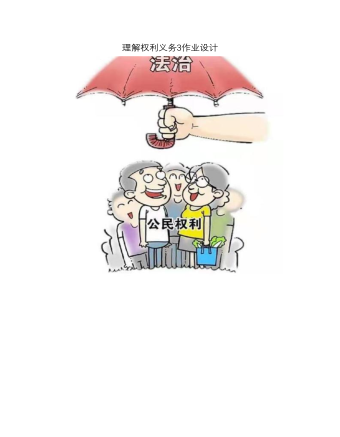
道德与法治八年级下册理解权利义务3作业设计
2.内容内在逻辑本单元为八年级下册第二单元内容。本单元由导语、第三课和第四课组成、第三课“公民权利”设有两课,分别是“公民基本权利”和“依法行使权利”、第四课“公民义务”设有两框,分别是“公民基本义务”和“依法履行义务”。单元导语首先明确中学生在国家中具有公民身份,是国家的主人,依法享受公民权利并承担公民义务。指明公民基本权利和义务是宪法的核心内容,从而激发学生学习公民基本权利和义务具体内容的兴趣。引导学生进一步探究如何依法行使公民权利、如何依法履行公民义务,思考依法行使公民权利、履行义务对个人、家庭、社会及国家的重要意义。引言指明了公民权利对于我们参与社会生活、实现人生幸福的意义,意在引发学生对公民权利在个人成长、社会进步与国家发展方面所具有的价值的初步思考,启发学生思考如何依法行使和维护自身享有的公民权利,进而导入新课。
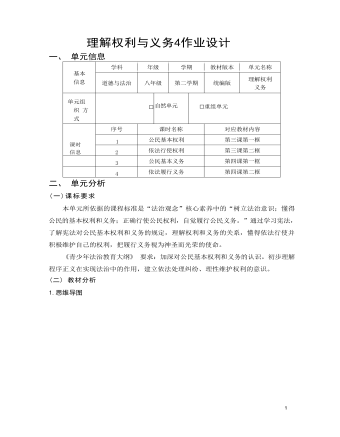
道德与法治八年级下册理解权利义务4作业设计
某小区突发火情。消防中队接警后迅速赶来, 但由于沿途不少车辆乱停放堵 住道路, 消防车无法顺利进入小区。危急时刻, 小区一名热心大姐奋力呼救, 号 召周围居民配合物业人员一起用人力将沿途车辆一一搬开, 这才让消防车顺利抵 达起火楼栋,经过及时疏散,无人员伤亡。某校八(2)班以上述新闻为背景,组织一次以“依法行使权利,让生命通 道畅通”为主题的社会实践活动。请你参与其中。 (1)调查组的同学在某小区发现有一辆私家车占用了消防通道。联系车主后, 该车主说: “我自己的车, 想停哪儿就停哪儿, 哪有那么多火灾! ”请你从“权 利与义务的关系”的角度对其进行劝说该如何处理好权利和义务的关系。①公民的权利与义务相互依存、相互促进。 ②公民既是法定权利的享有者, 又是法定义务的承担者。 ③我们不仅要增强权利意识, 依法行使权利, 而且要增 强义务观念, 自觉履行法定的义务。因此, 作为小区居民, 我们在依法行使停车 权利的同时也要自觉履行维护小区消防安全的义务。
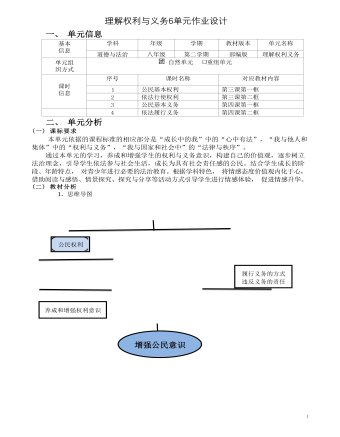
道德与法治八年级下册理解权利义务6作业设计
1.【解析】根据教材所学,依法治国要求全民守法,正确行使权利,自觉履行义务, A项没有履行依法纳税的义务,排除; B项没有履行服兵役的义务,排除;C项侵害救火英雄的名誉权,是一种违法行为,要承担相应的法律责任,故排除;D项自觉履行了维护国家安全和利益的义务,故符合题意。【答案】D2.【解析】该题考查公民的权利和义务的关系; 依据课本内容,公民的权利和义务是一致的。公民的权利和义务是密不可分的, 没有无义务的权利,也没有无权利的义务;题干中“不愿履行或轻视义务”割裂了权利与义务的关系,没有树立起正确的权利义务观念。 所以A项正确; BCD错误。【答案】A。3. 【解析】本题主要考查遵守宪法和法律这一公民基本义务。遵守和维护社会秩序是这一基本义务的具体要求,不服从国家疫情封控管理属于扰乱社会秩序的违法行为, 要承担一定的【答案】(1) 劝阻爸爸。(2) 自觉维护社会秩序, 依法履行公民义务, 法律要求的必须做,禁止做的坚决不做,否则就会受到法律制裁。
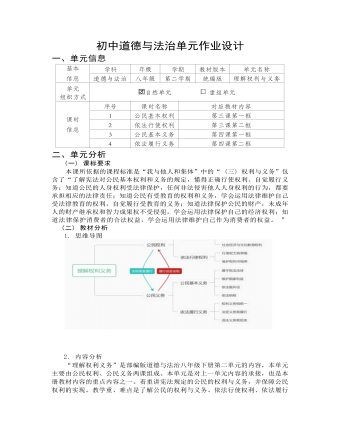
道德与法治八年级下册理解权利义务7作业设计
②积极参与国家事务和社会事务的管理③在享有劳动权利的同时,也履行了劳动的义务④既获得了劳动报酬,也为国家和社会作出了贡献 A.①② B.②③ C.①④ D.③④11.2020 年 6 月 19 日,国家林业和草原局、农业农村部发布通知,就《国家重点 保护野生动物名录》公开征求意见。画眉、啄木鸟、田螺等被增列入名录中,55 个鲸豚类和猛禽类等物种保护等级升级。作为中学生,保护野生动物是:( ) A.法律禁止做的,我们坚决不做 B.法律要求做的,我们必须去做C.道德要求做的,我们积极去做 D. 自觉自愿行为,可做也可不做 12.遇到交通肇事,不按照正常程序处理,而是采取极端的方式解决。陕西省榆 林市公安局榆阳分局镇川派出所,对涉嫌非法入侵他人住宅的 5 名嫌疑人刑拘。 这表明:( )①公民的住宅不受侵犯②禁止非法搜查或者非法侵入公民的住宅③公民权利如果受到损害,要懂得依照法定程序维护权利④我们在行使自由和权利的时候,不得损害其他公民的合法的自由和权利
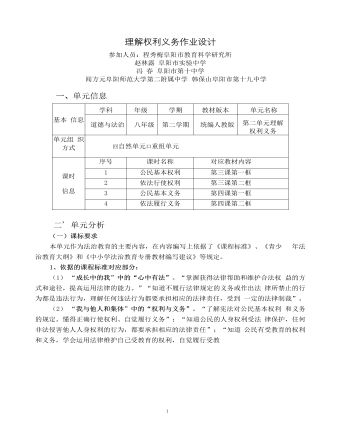
道德与法治八年级下册理解权利义务作业设计
4.阅读材料,回答问题:疫情防控期间,一方面,公民面临着被感染的风险,有权获得政府和社会组 织提供的专业服务与保障。为此,国家有关部门出台了免除个人医疗费用负担的 政策,让广大患者消除了疾病治疗的后顾之忧。另一方面,公民也应当成为疫情 防控中的责任主体之一,依法履行自己的义务,如实报告自己的健康状况,配合 相关管理部门做好居家隔离。(1)结合材料,分析公民行使权利与履行义务之间的关系。(2)作为青少年,我们应该如何履行法律义务?5. 阅读材料,回答问题:2021年3月1日,《中小学教育惩戒规则(试行)》(以下简称“《规 则》”)正式施行。《规则》指出,学生有下列情形之一,学校及其教师应当予 以制止并进行批评教育,确有必要的,可以实施教育惩戒:(一)故意不完成教 学任务要求或者不服从教育、管理的;(二)扰乱课堂秩序、学校教育教学秩序 的;(三)吸烟、饮酒,或者言行失范违反学生守则的。
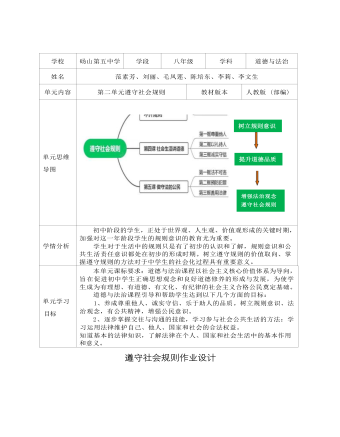
道德与法治八年级下册遵守社会规则作业设计
作业设计是老师布置给学生学习任务的设计,是教学设计的有机组 成部分。它以学习目标为起点,以学习内容为依托,以学习评价为保障, 以发展学生素养为最高标准。作业设计的要素包括作业内容、时间要求、 设计意图、作业分析及作业评价。我们八年级道德与法治组将单元作业 设计为三部分,第一部分是课时作业,本部分通过设置习题和活动,达 道巩固知识立德树人的目标。第二部分是单元作业,主要是为了检测学 生是否达到了单元学习目标,这部分重点考查学生对基础知识的掌握情 况。第三部分是特色作业,增强家国情怀,提高主人翁意识,更加注重 学生的能力提升。进入八年级,知识内容不断加深,同学们在学习方面面临着更大的 挑战,一部分学生因此产生畏难情绪,感觉学习吃力,如果在作业设置 方面,设置的作业量过大或过难,容易让学生彻底失去学习的兴趣,从 而放弃学习。

国旗下的讲话演讲稿小学四年级作文
尊敬的老师、亲爱的同学们:大家早上好!我是四年级七班的张笑寒。今天国旗下讲话的题目是《做一个有道德的人》。同学们,你们知道9月20日是什么日子吗?让我来告诉你们吧!是“公民道德宣传日”。未成年人是祖国未来的建设者,是社会主义事业的接班人!我们肩负使命!我们任重道远!古往今来,沧海桑田,虽时光流逝,但美德未减。骁勇善战的霍去病,毅然隐世的陶渊明,慷慨悲歌的文天祥,精忠报国的岳飞,虎门销烟的林则徐,拒领“救济粮”的朱自清……再看看新时代那些当之无愧的道德英雄:“雷锋传人”——郭明义,舟曲之子——王伟,警界保尔——孙炎明……他们是民族的脊梁,他们是道德的旗帜,他们是人格的丰碑。意大利诗人但丁说过:“一个知识不全的人,可以用道德去弥补,而一个道德不全的人,却难以用知识去弥补。”在家里,让我们为忙碌了一天的父母捧上一杯热茶;在学校,让我们为学习困难的同学把疑问解答;在车上,让我们扶着年迈的老人坐下。只要我们从现在做起,从小事做起,我们就会成为有道德的好少年。同学们,让道德的种子在我们心里生根,发芽!让我们一起努力,加油吧!谢谢大家!

人教版新目标初中英语八年级上册How do you make a banana milk shake教案2篇
1. First, ... then, ... next, ... finally, ...首先,……然后,……接着,……最后,……这是英语中表达做某事的步骤的一种说法。如果步骤较多,还可以说:first-next-after that-later on-finally/at last通常你会听到说英语国家的人在说 first, next, then, finally 和后面的内容时,他们会做一些停顿。这样就能提前告诉听者接下来讲的是一系列的步骤。这一点在朗读和听力中应特别注意。2. how many, how much均为疑问词,同是“多少”,但用法不同。请看:how many修饰可数名词复数,how much修饰不可数名词。但在用法上,同学们常犯如下错误:1) [误] How many are there bananas on the table?[正] How many bananas are there on the table?[析] how many, how much 中的many,much是形容词,常修饰名词作定语,故后面跟名词。2) [误]How much tea are there on the table?[正]How much tea is there on the table?[析] how much修饰不可数名词时,谓语动词用单数。how many与how much的区别可简记为:前how many:问“多少”,复数名词后面跑;how much问“多少”,不可数名词单数好。前者答语用基数词,后者答语用数量关系。

人教版新目标初中英语八年级上册How was your school trip教案2篇
“Go for it!” is based on “Task-Based Language Teaching”. It adheres to “The authenticity principle”, “The form-function principle”, “The task dependency principle” and “The principle of learning by doing”. These principles all accord with the demands of curriculum focus.In and of Grade Seven (II), “Go for it!”, students have learned “The Simple Past Tense”. And it appears again in of Grade Eight (I). teaches students more about how to talk about events in the past. In addition, it gives affirmative and negative statements in the past tense, such as the sentence patterns “Did you see …?” “Were there …?” “Did you go …?” As the first part of Unit 8, Section A opens with a picture presenting the last school trip in the aquarium and continues with several step-by-step practice activities, which are all good for students to master “The Simple Past Tense”. Doing well in Section A will help students integrate the new target language with that in Section B. Thus, they can describe the events in the past freely and foster their own ability of reflecting and practicing. II. Teaching ObjectivesTeaching objective is the beginning and aim of teaching activities. According to the overall goal of the English elementary course--- improve students' synthetic ability of language application, which should be based on the development of students’ “Language knowledge”, “Language skills”, “Character building”, “Learning strategies” and “Cross-cultural awareness”. The teaching objectives are described as follows(I). Knowledge objectivesi. Master the simple past tense of regular and irregular verbsii. Recite the new words and expressions about the last school trip in the aquarium, including their pronunciation and intonation

人教版新目标初中英语八年级上册How do you get to school教案2篇
Step Ⅶ Role play ( Work on 1b)1. First ask two students to read the dialogue to the class.Sa: How do you get to school?Sb: Well, I ride my bike to the subway station. Then I take the subway.2. Now work with a partner.Suppose you use two kinds of transportation to get to school \Hangzhou\Beijing... (bus, train, subway, walking, bike, etc.) Tell how you get there. You may use the phrases in 1a.3. Then ask different pairs of students to present their conversations to the class.Step ⅧListening1. Work on 2a(1) First ask students to read the list of information that Thomas wants to know.…where Nina lives.…how far from school she lives.…how long it takes to get to school.…how she gets to school.…what she thinks of the transportation.(2) Tell students what transportation and bus stop mean.bus stop 汽车站 transportation n. 运送;运输Then tell students we'll hear a recording. Please put a checkmark in front of each thing that Thomas wants to know.(3) Now play the recording for students.( Have students pay attention to the sample answer.) (4) Then correct the answers.

人教版新目标初中英语八年级上册What are you doing for vacation教案2篇
Teaching goals : 1. Words & phrases: babysit ,get back , fishing , rent , think about , decide(on) , tourist etc. 2. How to talk about future plans . 3. 现在进行时表示将来计划或行动. 4. 特殊疑问句(where , when , how long引导) Important and difficult points : Drills :What are you doing for vacation ? I’m watching TV . When are you going ? I’m going … . How long are you staying ? We’re staying for five days . Teaching aids : cards and a tape ,a large wall calendar . Period 1 Teaching procedures : Step 1Leading in1. Free talk . 2. Put up the wall calendar . T: I’m staying home on Saturday (pointing to next Saturday ).Ss repeat . Ss: I’m staying home on Saturday . T: OK. Today we’ll learn how to talk about future plans. Step 2Pre-task SB Page 13 , 1a . 1. Look at the picture carefully and tell what you see in the picture . 2. Write the activities from the pictures in the box and add some more . 3. Practice reading . Step 3While-task1. Using the activities we write in 1a to make conversations .For example :What are you doing for vacation ? I’m visiting my uncle . 2. Pairwork .Practice in pairs . 3. 用第三人称练习对话.

人教版新目标初中英语八年级上册I’m more outgoing than my sister教案2篇
1 交通工具的比较此活动为小组活动。学生通过讨论找出到达某一城市可乘坐的各种交通工具,并选择最佳出行方式。Teacher:We’re going to Shanghai. How many ways can we use to get there? Yes, there are four ways: by bus, by plane, by train, by ship. Please discuss how you are going to get there.操作建议:(1)学生以小组为单位展开活动,谈论本组所选择的交通工具。(2)各组选代表向全班汇报,阐述本组所选择的交通工具的利和弊。完成任务所需要的语言结构:We can go there by ship. It’s more comfortable and cheaper than any other transportation.We can go there by bus. It’s cheaper but it takes longer time.2 哪个城市更合适?此活动具有挑战性。假设中国要举行2014年世界杯足球赛,分别从历史,人文,天气等方面对各城市(北京,大连,上海,昆明)进行比较,选择最佳举办城市。T: Imagine China is holding the 2014 FIFA World Cup. Which city do you think is the best for the World Cup, Beijing, Dalian, Shanghai or Kunming? Let’s work in groups. If you choose Beijing, please join the Team Red. If you chose Dalian, please join the Team White. If you choose Shanghai, please join the Team Blue. If you choose Kunming, please join the Team Green. Please show us its advantages. Then let’s see which team will win.

人教版新目标初中英语八年级上册What’s the best radio station教案2篇
教学重点和难点:运用所掌握的语言描述,比较不同地点的特点。在练习中学习掌握英语比较级和最高级的用法。课前准备分配小组,每组五至六人。通过上网或翻阅报刊杂志等方法,确定旅游线路,做出基本的旅游计划。教学设计:本节课流程图 学法指导:1.由于这是一堂新课,在教学中应注意面向全体,发挥学生的主体性,引导学生积极参与,激发学生的求知欲和学习积极性,指导学生积极思维,主动获取知识,养成良好的学习方法。逐步学会独立解决问题。总之要尽可能调动学生的非智力因素促进智力因素的发展。教法选择:1.电化教学法2.课堂讨论法3.任务型教学法采用这些方法的目的是为了充分调动学生的学习积极性,使学生变被动学习为主动学习。通过电脑形象的演示,加强印象,提高兴趣,突破难点,提高教学效率,进而增大教学的容量和信息量。充分体现教师为主导,学生为主体的教学原则。

人教版新目标初中英语八年级上册What’s the matter教案2篇
She shouldn’t go to the party tonight.Step7. TaskT: You know, there are lots of problems in our life. If you are a doctor, please tell us how to solve the problem. I will divide you into 9 groups. Please work in groups. And then choose one of you to report your ideas.The following are the problems:I have a toothache.I am hungry. I have a sore throat.I am stressed out. I have a sore back.I am tired. I can’t sleep.I have a cold. I have a headache.Report: If you have a headache, you should go to bed early. You should see the doctor. You should eat some medicine. You shouldn’t wash your face with cold water.You shouldn’t sleep late.You shouldn’t swim.…..T encourages the students to give advice as much as possible.Homework:1. Chose one of the problems, and write down your advice2. Copy the new words这一步是用于热身的,同时也可以让他们复习一部分的表示人体部位的单词,扩充知识.学习语言的过程也是一个不断积累的过程,复习旧知识,增添新知识.通过小游戏,强化学生对Does she/he have…这个句子的运用能力.通过复习,自然的引到下面新知识的学习。充分利用表格,由句子到对话,再到文章,让学生循序渐进. 提高学生的综合语言运用能力,运用以前学过的知识来解决身边的问题.Period 5 (Section B 3a—3c, selfcheck)教学内容与分析:
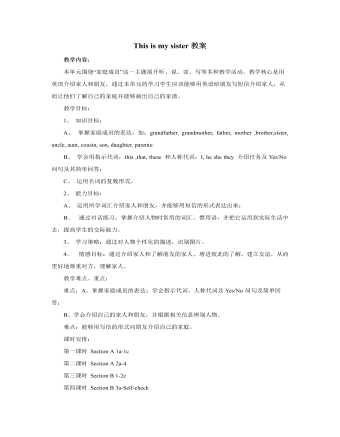
人教版新目标初中英语七年级上册This is my sister教案
(Play the recording twice again.) (Check the answer.) ③Pairwork. Draw your own picture and talk about it. T: We find out the picture of Lin Hai’s family. Can you draw a picture of your family? SS: … T: OK. When you finish drawing, tell your partner about your picture. You can use “This is …” and “ These are …” to talk about. Then report it to the class. (Students work.) (Check students’ work. Ask two or three students to report.) Step Three: Task. Talk about the family tree. T: Look at the family tree. I think it’s a big family. You can do it in groups of four or three. You can do it in pairs or only by yourself. Then report it to the class. (Students work. Teacher walks around in the classroom and helps the students.) T: Stop here. Let’s check it out. (Choose students to do it.) S1: Look at my family tree. This is my… This is my … They have two … This is my … This is my …This is my …This is my. My parents have two children. This is…This is my …My uncle and my aunt have a son. He is my … (Ask two more students to do it.) Homework. Write a passage about your family.
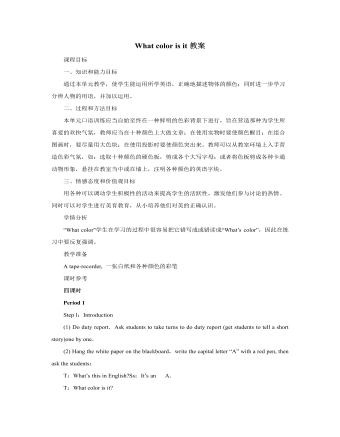
人教版新目标初中英语七年级上册What color is it教案
一、知识和能力目标通过本单元教学,使学生能运用所学英语,正确地描述物体的颜色;同时进一步学习分辨人物的用语,并加以运用。二、过程和方法目标本单元口语训练应当自始至终在一种鲜明的色彩背景下进行,旨在营造那种为学生所喜爱的欢快气氛,教师应当在十种颜色上大做文章;在使用实物时要使颜色醒目;在组合图画时,要尽量用大色块;在使用投影时要使颜色突出来。教师可以从教室环境上入手营造色彩气氛,如:选取十种颜色的硬色板,剪成各个大写字母;或者将色板剪成各种卡通动物形象,悬挂在教室当中或在墙上,注明各种颜色的英语字块。三、情感态度和价值观目标用各种可以调动学生积极性的活动来提高学生的活跃性,激发他们参与讨论的热情。同时可以对学生进行美育教育,从小培养他们对美的正确认识。
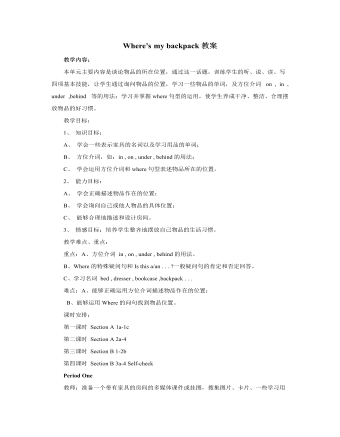
人教版新目标初中英语七年级上册Where’s my backpack教案
教师: 搜集单词卡片、背景资料。 学生:彩笔、大白纸、相关新单词。 教学设计 Step One: Learn the new words. 1.Present the new words. (Show some pictures and words on the screen to teach the students the new words.) T: What’s this? S1: It’s a room. T: Do you have a room like this? S2: Yes, I do./ No, I don’t. T: Read after me. R-O-O-M, room. Ss: R-O-O-M, room. (Teach the other words “TV, desk, picture” in the same way.) T: There are some words here. Read the words after me and spell them. (Learn the other words without pictures on the cards.) T: This is a word. Can you spell this word? (Point to a word in the card.) S1: Yes, I can. / No, I can’t. (Let them know the meaning of “can”.) T: I can spell your name. Can you spell my name? S1: Yes, I can. T: Can you write your name? S: Sorry, I can’t. I have no pen. T: You need a pen.( Give him a pen.) ( Let the students understand the word “need”.) T: I bring a football to school every day. Now it is on the floor. After class I take it to my home. (Teach “bring” and “take”. Put a football on the floor and point to the floor to teach the word “floor”.) 2.Practice the words. (Give the examples to the students and get the students to understand the new words.) Step To Listen and practice.
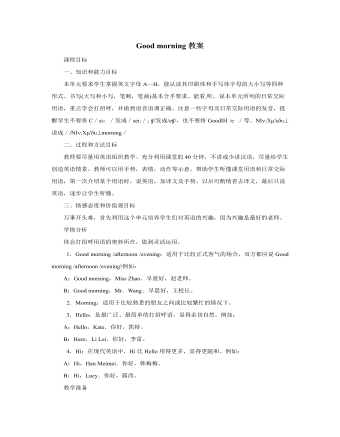
人教版新目标初中英语七年级上册Good morning教案
一、知识和能力目标本单元要求学生掌握英文字母A—H,能认读其印刷体和手写体字母的大小写等四种形式。书写(大写和小写,笔顺,笔画)基本合乎要求。能看,听,说本单元所列的日常交际用语,重点学会打招呼,并做到语音语调正确。注意一些字母及日常交际用语的发音,提醒学生不要将C/si:/发成/sei:/; ?/发成/e?/,也不要将Good?H /e /等。??????'????说成/???????'???morning/二、过程和方法目标教师要尽量用英语组织教学。充分利用课堂的40分钟,不讲或少讲汉语,尽量给学生创造英语情景。教师可以用手势,表情,动作等示意,帮助学生听懂课堂用语和日常交际用语,第一次介绍某个用语时,说英语,加译文及手势,以后可酌情省去译文,最后只说英语,逐步让学生听懂。
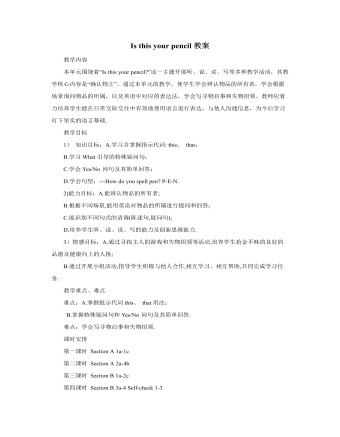
人教版新目标初中英语七年级上册Is this your pencil教案
T: Please look at the pictures and learn the new words.(用多媒体展示新单词效果较好。)1.at prep. 在(里面或附近);在(点刻);2.theart.表示特指的人、物、事或群体 3.lostadj.丢失的;遗失的4.Found adj. (find的过去式、过去分词)找回的5.lost and found 失物招领6.please adv.请7.school n. 学校8.a set of一套;一副(Teach students to read the words.)2. Practice the new words. (事先录制一段短的听力,让学生通过听的训练来强化所学的新单词,并为学习写寻物启示和失物招领作好准备。)T: Please listen to a short passage twice then fill the blanks using the words we learned.(Show students a short passage and play the recording for the students to listen.)There are many things in (1)_____________________in my (2)__________. Look, here’s (3)_________keys. Is this yours? (4)__________call Jim (5)___________753-2289.Typescript:There are many things in the Lost and Found in my school. Look, here’s a set of keys. Is this yours? Please call Jim at 753-2289.
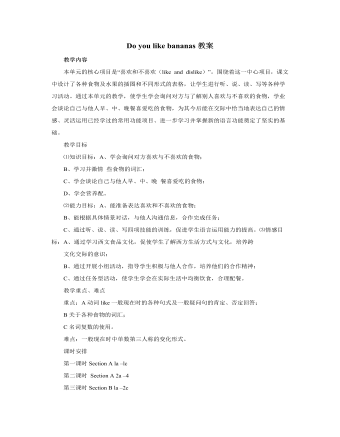
人教版新目标初中英语七年级上册Do you like bananas教案
教学目标 ⑴知识目标:A、学会询问对方喜欢与不喜欢的食物; B、学习并激情 些食物的词汇; C、学会谈论自己与他人早、中、晚 餐喜爱吃的食物; D、学会营养配。 ⑵能力目标:A、能准备表达喜欢和不喜欢的食物; B、能根据具体情景对话,与他人沟通信息,合作完成任务; C、通过听、说、读、写四项技能的训练,促进学生语言运用能力的提高。⑶情感目标:A、通过学习西文食品文化,促使学生了解西方生活方式与文化,培养跨 文化交际的意识; B、通过开展小组活动,指导学生积极与他人合作,培养他们的合作精神; C、通过任务型活动,使学生学会在实际生活中均衡饮食,合理配餐。 教学重点、难点 重点:A动词like一般现在时的各种句式及一般疑问句的肯定、否定回答; B关于各种食物的词汇; C名词复数的使用。 难点:一般现在时中单数第三人称的变化形式。







